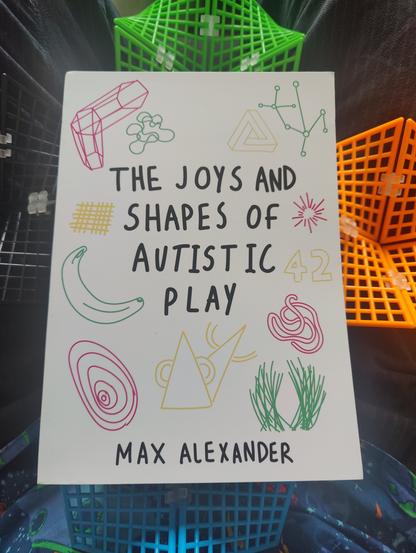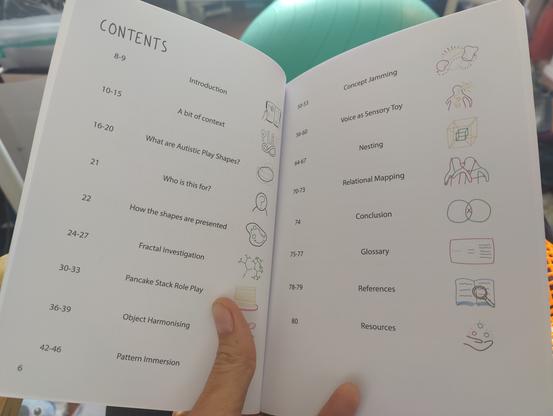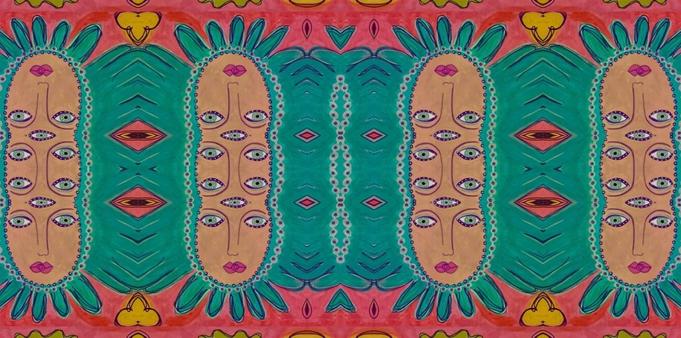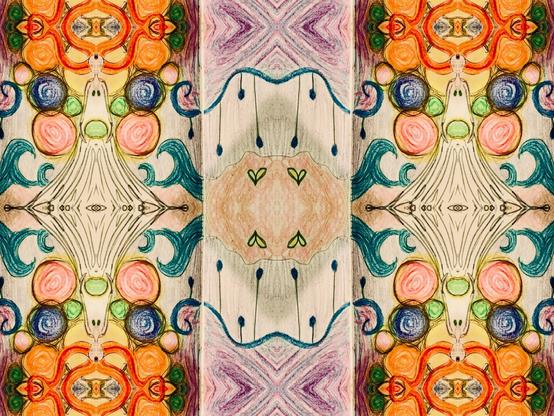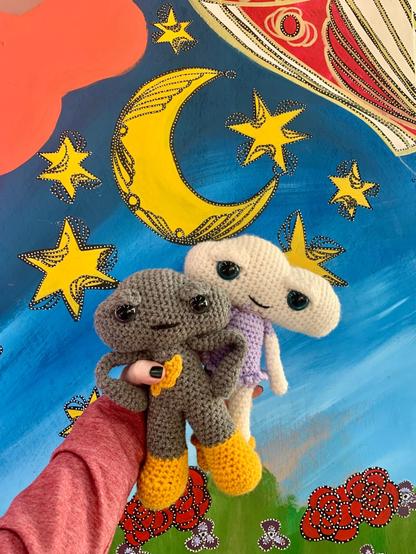Just gonna drop this in the #monotropism feed
RE: https://bsky.app/profile/did:plc:l5lyjtzvlwmnyhi2bn4cxiyk/post/3lrtcqe6d3c26
#Monotropism
whoops I crocheted too much for a few days and now my brain doesn’t want to do ANYTHING BUT #crochet
Monotropism, and the subsequent work of Tanya Adkin in conceptualising Monotropic split, has been an incredibly meaningful set of ideas for the neurodivergent community. One of the most common questions, however, has been- How do we fix it?
This article aims to answer that question. This is a solution to Monotropic split.
#ActuallyAutistic #autism #monotropism #MonotropicSplit #AutisticWellbeing
My copy of The Joys and Shapes of Autistic Play has arrived! By Max Alexander (Play Radical), this beautiful 80-page book playfully explores autistic approaches to play. Download for free and order a physical copy here: playradical.com/the-joys-and... #monotropism #playTherapy #Neurodiversity
This is a really nice 3-minute explanation of #monotropism!
Joe is monotropic about football.
@monotropism.bsky.social
youtu.be/8ypHOIBHJ6o?...
Football, Autism and Monotropi...
@maloki whoops just did 81 without stopping 😂 #monotropic #monotropism
Monotropism Reflected in the Communication Style of Artistic Expression
Becca Cook is an AuDHD artist, animal communicator, and writer.
Monotropism is a cognitive tendency often present in autistic individuals, characterized by an intense focus on one or two interests at a time. My attention feels like a narrow beam of light, bright, deep, and consuming. This focus creates a rich inner world, one where thoughts and emotions spiral into deep connections of complex understanding. While this kind of focus can seem limiting to those who process information in a more multi-tracked way, monotropism has its own unique power. It creates depth, meaning, and complexity that might not be reachable through broader, surface-level engagement.
Artistic expression, in my experience, becomes more than a medium, it’s a language. I often say artistic expression is my second language, my first being energetic communication and third being language and words. Artistic expression is a bridge between inner experience and outer reality, where the intensity of focus condenses into a form that can be shared with the world. I have always felt communication through traditional verbal or social means can feel restrictive. Words often feel too linear, too fragile to hold the weight of multi-dimensional thoughts and emotions. But art? Art is a vessel wide enough to carry that depth.
Art made through monotropism tends to be layered and complex. The work may not be consciously planned, but emerges as a natural outcome of deep immersion. Like the fruiting body of a mycelial network, what appears on the surface is just the culmination of much deeper, hidden processes. This artistic communication often feels oracular, holding meaning that even I may not fully understand until later. The art becomes a mirror, a map, a code. It’s a kind of communication that is less about explaining and more about revealing, with layers of interpretation available to anyone who looks deeply enough. In my experience art is a way in which I communicate with myself, primarily in feelings and emotional states.
When I work on an art piece, I rarely start with a specific goal. Instead, I follow the pull of my focus, allowing the process to guide me. The art grows organically, shaped by my emotional and intellectual rumination. It feels like dreaming, where symbols arise naturally, carrying insights that only make sense with time. Often, I’ll finish a piece and only later recognize what it was expressing. Sometimes, I realize it predicted patterns or trends I wasn’t aware of at the time. This is not about mysticism but about how deeply the monotropic mind processes information, connecting threads beneath conscious awareness.
In this way, monotropism becomes an artistic strength. It allows for prolonged immersion, enabling me to build work that carries a kind of depth not easily reachable through fleeting, surface-level engagement. Each piece is multi-dimensional, layered with emotions, concepts, and connections. It becomes a conversation with the self, but also with the world an offering for others to explore and interpret.
My approach to art created through monotropism doesn’t aim to please or entertain. It isn’t designed for quick consumption or easy interpretation. Instead, it holds an invitation to slow down, to feel, to notice. It asks the viewer to enter into its depth, to experience the layers of thought and emotion woven into its creation.
This is why artistic expression is one of the most authentic and powerful forms of communication for my monotropic mind. It’s not about conforming to linear explanation but about holding space for complexity. It’s about allowing the unconscious to speak, trusting that meaning will unfold in its own time, in its own way.
In a world that often rewards speed, efficiency, and clarity, monotropic art defies these expectations. It values depth over breadth, process over product, patience over quickness. It holds the quiet power of being wholly present with one thing at a time, allowing that presence to shape what is born.
By: Becca CookInstagram: @beccacookart
License: All Rights Reserved
My interview with Jesse Meadows for 'Sluggish' is up! Podcast + transcript.
We talked about #WeirdPride, #monotropism, being #autistic and #ADHD, #flow states and a bunch of other stuff.
I hope you enjoy this as much as I did! Jesse is an excellent interviewer.
My interview with Jesse Meadows for 'Sluggish' is up! Podcast + transcript.
We talked about #WeirdPride, #monotropism, being #autistic and #ADHD, #flow states and a bunch of other stuff.
I hope you enjoy this as much as I did! Jesse is an excellent interviewer.
open.substack.com/pub/sluggish...
"Autistic pride is impossible ...
Autism and Being Monotropic: What Medical and Other Practitioners Need to Know by Wenn B. Lawson, 2025
This book provides a comprehensive overview of the experiences and challenges faced by autistics who have not been understood or accommodated due to their monotropic cognitive style.
It's been more than a third of a century since most of the key ideas needed to make sense of autistic experience were formulated.
It's encouraging to see people finally starting to listen, but frustrating that it's taken so long, and infuriating that so many people (and organisations) still haven't caught up.
I wrote about the key lessons people should have learnt by now from the autistic community.
#waad @actuallyautistic #autistic #neurodiversity #monotropism
It's Autism Day/Month, and I keep telling people they need to learn from autistic people... But what do they most need to know?
It's funny, none of the key autistic theories about autism are just about autism: #Neurodiversity, #Monotropism, #DoubleEmpathy.
oolong.medium.com/506c7d649823
Autistics on Autism
Just went straight past my train station because I was too focused on writing about attention tunnels. 😑🚇 Glad I decided to get an earlier train than I thought I needed! #monotropism
offering breathing
to my monotropism
is like giving medicine
to a dog
#Poetry #ShortPoem #SmallPoems
#Meditation
#ActuallyAutistic #Monotropism
Just discovered that monotropos and polytropos appear in Homer! #monotropism "It appears that someone who is capable of applying multifarious forms of approach to others must be called polytropos, [...]
Been making a concerted effort to reduce monotropic split and help my injured monotropic brain heal. Dedicated, protected monotropic mornings make such a big impact, I wish I'd thought to try sooner
- Waking up alone, no spouse or dogs until I'm ready
- Light tunneling in my daily notebook (especially nonverbally, just doodling or decorating)
- No phone or anything verbal until after my monotropic morning
1-2 hours is amazing, but even 15-20 mins is so, so, so nourishing good
@actuallyautistic Several weeks ago, I undertook to post more about the concept of the #kaleidotropic mindset — a further development of the classic concept of the #monotropic mindset underlying autism. I'm continuing to develop my thoughts on these topics, but they are threatening to overrun even the 5000-character limit of the zeroes.ca Mastodon server — in fact, they're starting to look more like something I'd consider submitting to NeuroClastic than like a Mastodon post. Also, I've now realized that if I'm right, it's not just the theory of #monotropism that will need to be revised, but the formal diagnostic criteria for autism as well. So rather than try to wait until my thought process is complete, I'd like to share something of the current state of my thinking — especially what I consider to be most essential.
The concept of #kaleidotropy was suggested to me as a consequence of my recent self-diagnosis in late 2024; while I appeared to be mostly a very good fit for C.L. Lynch's Person One (a classic "aspie"-type autist), there were a few important details that didn't fit. In particular, while I definitely shared the characteristic #monotropic intensity of attentional focus, I felt that the characterization of my interests as "narrow and restricted" was not merely untrue, it was the exact polar opposite of the truth. Intensity of focus and narrowness of focus don't necessarily correlate. Although my self-diagnosis and my familiarity with the concept of #monotropism are very recent, I've known for a very long time that my interests and my focus of attention were a departure from the norm, and in a very different way than the concept of #monotropism or the formal diagnostic criteria for autism would suggest. I've been aware that my interests were broader, AND deeper, AND more labile, than is typical for most people — the supposedly #polytropic neurotypicals emphatically included. To me, THEY are the ones whose interests are narrow and restricted!
I realize that this assertion is likely to be challenged — and my attempts to anticipate and answer those challenges has been one of the principal reasons for the rapid growth in volume of this material. Unlike autism — which is so heavily stigmatized that a self-diagnosis on inadequate grounds is usually unlikely — CURIOSITY mostly has a very favorable reputation. Implying that someone's supply of it might fall short of the theoretically possible maximum can look like an accusation of stupidity, and tends to draw emphatic denials. But rather than present the considerable evidence available, to the effect that my interests really do exceed the norm along several different dimensions, I'd like that possibility to be at least taken seriously for the sake of argument — and consider how and why such a state of affairs could be consistent with a diagnosis of autism.
In the theory of #monotropism, the characteristic social difficulties of autistics are explained in terms of an inability to allocate attentional focus optimally for social interaction. Social adroitness requires a myriad of things to be monitored in real time — a task calling for #polytropic breadth of attention. The formal diagnostic criteria for autism simply require social difficulties and a restricted range of interests both to be present, while remaining agnostic as to any potential causal relationship between the two.
What I suggest is that the theory of #monotropism has the causal relationship backwards. The fundamental characteristic of the neurotypical mindset, that separates it from autistic cognition, is precisely the intense and constant, though diffuse, focus on the social world. For this reason, I propose that this mindset be given not the misleading label #polytropic, but a more accurately descriptive characterization as #ecotropic — yoked tightly to the social environment. An #ecotropic mind has a wider focus of attention than SOME autistic minds, not because it CAN, but because it MUST. The complementary autistic mindset I term #autotropic — responsive to its own internal logic, rather than to the environment.
An #autotropic mind is thus under far weaker constraints than an #ecotropic one — and we would accordingly expect to see a much greater variety of subtypes within #autotropy. The classic, stereotypical #monotropic mindset is certainly one of these — the ability, for example, to focus exclusively on a single spinning object, oblivious to all else.
But other subtypes of #autotropy can also exist. Attention can be given, not to fewer, but to MORE topics at once, than is likely for an #ecotropic intellect subservient to its social surroundings. Likewise, while an #ecotropic attentional set is limited by external reality in the speed with which it can undergo change, this subtype of #autotropic intellect — which I term #kaleidotropic — can refocus from one entire panoply of topics to another in an instant. Just about anything can have the effect of Proust's madeleine.
It's just the nature of things, that when I have a lot on my plate, some things get pushed out of my head. Recently that's been the case with my photography posting on my socials. Anyway, here's a gnarly tree from a few weeks back.
